Disclosure: Meeple Mountain received a free copy of this product in exchange for an honest, unbiased review. This review is not intended to be an endorsement.
In this review anything that might be considered a spoiler is hidden in a collapsible window with a spoiler alert on it. In all other ways, this review is spoiler-free.
The two games in the Adventure Games series, The Dungeon and Monochrome Inc., are cooperative standalone games for one to four players in which you discover and engage in a story played out over three chapters. Both games play almost identically, but there are some unique elements in each, which will be discussed later in the review.
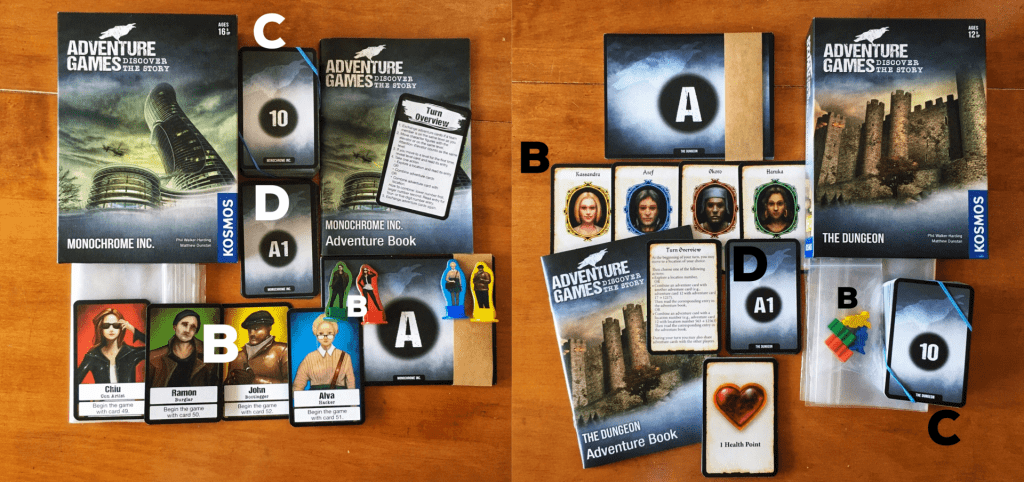
Each Adventure Game comes with Room or Level cards (A), Character cards and figures (B), Adventure cards (C), Mission cards and Ending cards (D), an Adventure Book, Turn Overview cards, and two plastic bags. Don’t look through any game material (cards and the Adventure Book) until the rulebook or the game instructs you to do so.
Adventuring
As previously mentioned, players are working cooperatively in the Adventure Games and playing through a story, with the choices they make affecting and changing the course of their game. While players are given a final score at the end of the three chapters, there is no way to necessarily win or lose.
In both Adventure Games (The Dungeon and Monochrome Inc.), you go through the following steps on your turn: move your Character figure then take one action. You may also exchange Adventure cards with other players; this can be performed at any time in The Dungeon, but is a little more complicated in Monochrome Inc. (more on this shortly).
Move Character Figure
On your turn you may freely move to any location, that is, anywhere depicting a three-digit number (called the location number). There is no restriction to how far you may travel, but in The Dungeon you may only move to Room cards that are revealed (faceup).
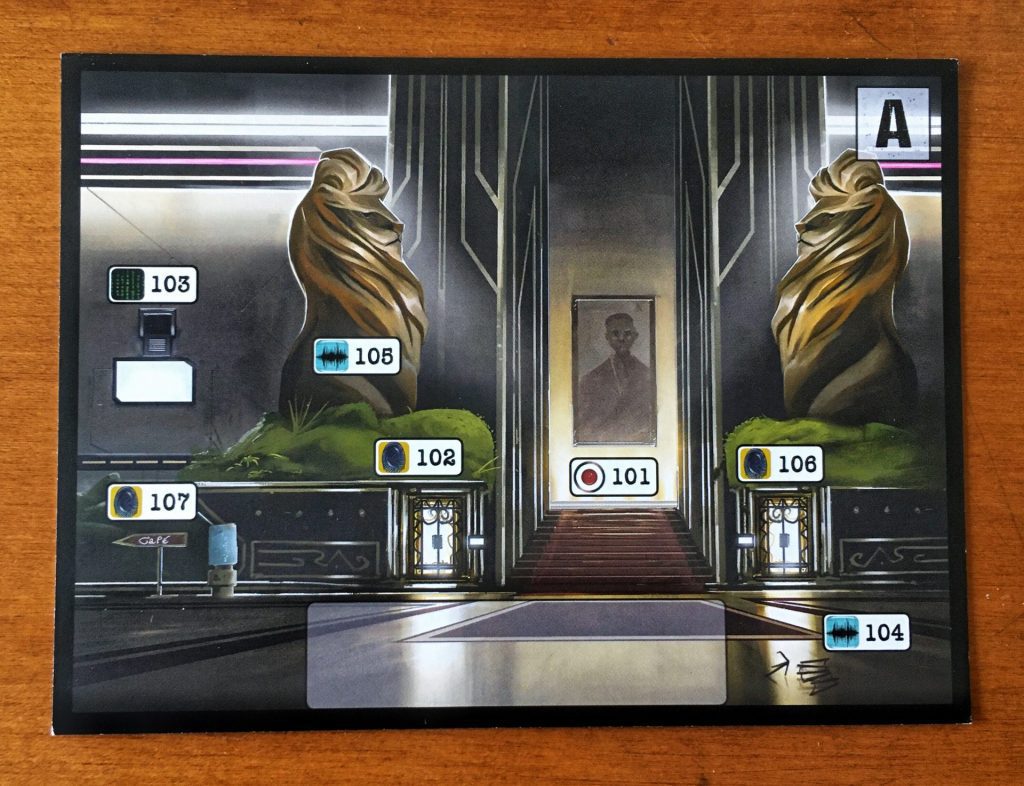
Take One Action
After you’ve moved your Character figure to a location, you may perform one of three possible actions:
- explore a location number,
- combine two Adventure cards with each other, or
- combine an Adventure card with a location.
To explore the location with your Character figure, read aloud the entry in the Adventure Book matching the three-digit location number (or have it read to you on the app). As the story progresses, you will reveal new Room cards and locations, gain new Adventure cards to add to your inventory, or replace and remove cards from the game. The Adventure Book clearly outlines any next steps you’re required to take. Since the Adventure cards are all about adventuring and developing a story, it’s possible that you’ll have to go back and revisit locations later in the game.
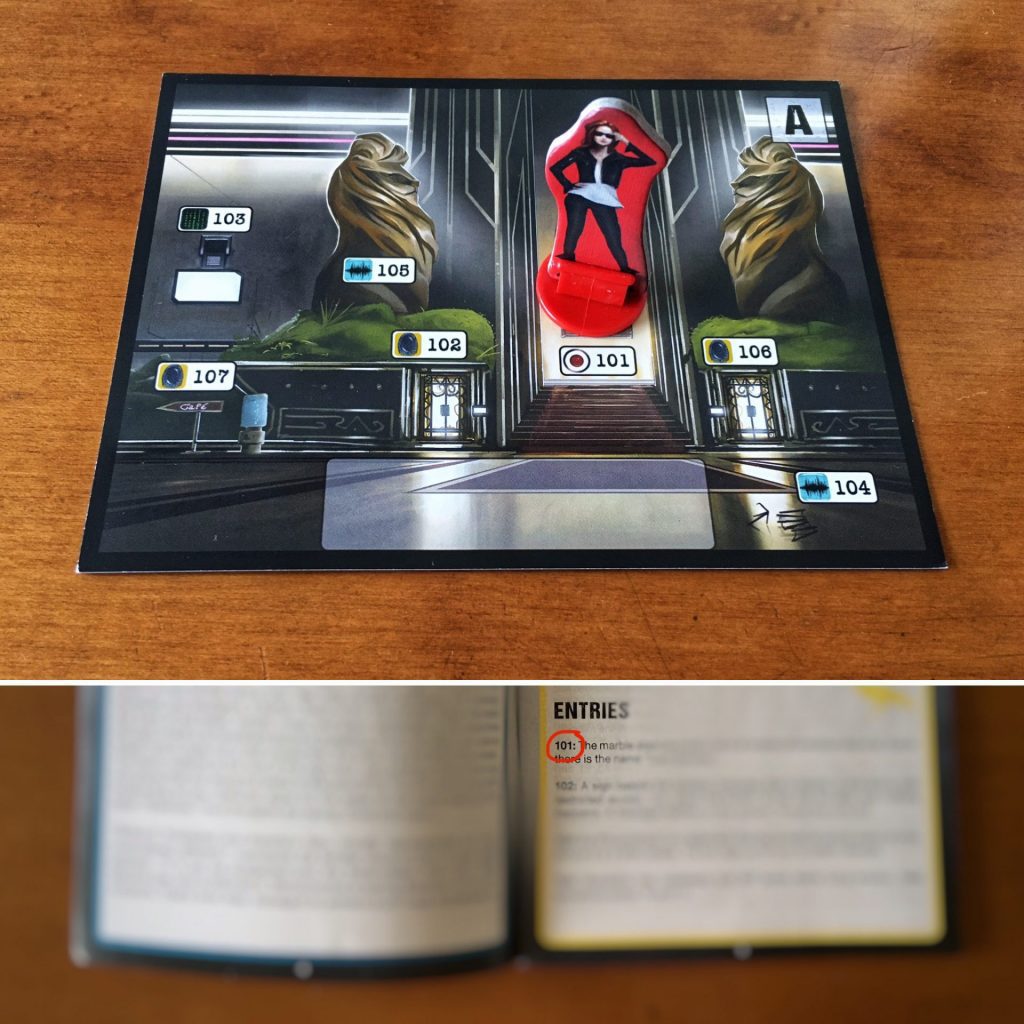
Over the course of the game, players gain Adventure cards, which range from found objects to pieces of information. These cards can be used in combination with other Adventure cards or locations to do things in the game. Each Adventure card has a two-digit number and each location has a three-digit number. To combine one Adventure card with another Adventure card or location, the numbers are combined together (not added). With this new combined number, look up the entry in the Adventure Book and read it aloud. If there is no such entry in the Book, then this isn’t a valid combination and you’ve used up your only action for that turn.
You can combine two Adventure cards with each other no matter what location your Character figure is on, but you may only combine your Adventure cards. This is why you might exchange Adventure cards with other players on your turn. To combine an Adventure card with a location, your Character must be on that location and you must have the Adventure card in your inventory.
Finishing A Chapter and Saving The Game
An Adventure Game is made up of three chapters, each lasting about 90 minutes. An entry in the Adventure Book will inform players once they’ve completed a chapter and then scores it. At this point, you may carry on with the next chapter or save your game. (You can actually pause and save your progress at any time, but the end of chapter is a good stopping point since it usually sums up your mission progress for that chapter and introduces what’s next.)
To save your game, follow the detailed explanation in the rulebook. Before you go dismissing it like my fellow adventurers and I initially did, you will be very thankful for this section after you’ve finished playing the chapter. Trust me.
All Heroic Adventures Must Come To An End
At the end of the third chapter, the tired adventurers find out how their story ends. Decisions that the team makes throughout each chapter shape the story’s ending. Players also then determine their final score for the game, but as the rulebook states, the score isn’t as important as the gaming experience itself.
Need Some Help?
The last few pages of the rulebook have hints for every Adventure card and location in the game. There’s no penalty for using hints and they won’t negatively impact your final score. These hints usually tell you what cards to combine and where, but sometimes they’ll tell you where to gain new cards. And while those examples are pretty helpful, some hints are a little more…sparse.

The App
Like many of KOSMOS’ other games (Exit: The Game, for instance), there is a digital tutorial for the Adventure Games available on the Kosmos Helper App. They have taken the digital (app) experience one step further by also including an audiobook version of the Adventure Book for The Dungeon and Monochrome Inc.
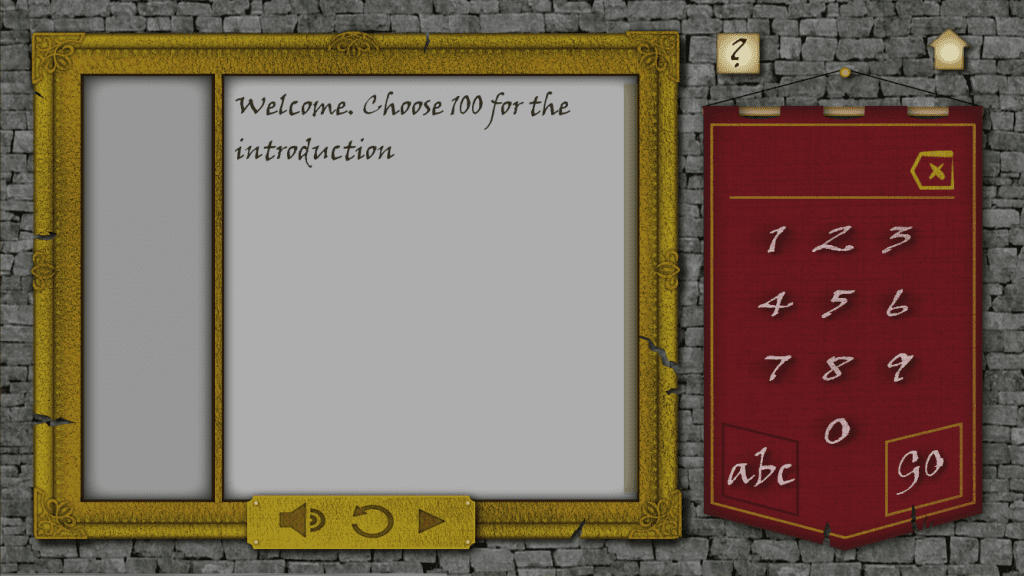
When we first started playing through the Adventure Games, the audiobook was not yet available. Luckily this meant that we played one game (Monochrome Inc.) without the app and one with it (The Dungeon).
App Advantages
There’s definitely something to be said for being read to. The practiced cadence of the voice actor is just nice to listen to, and given the amount of content in each Adventure Game, having real voice work is a definite treat. This perk is particularly useful for folks who are a little shy to read to the class.
But the acting isn’t the only perk to the app. When you explore a location or combine Adventure cards, punching in codes is a heck of a lot faster than flipping through the Book. It also insulates you against spoilers: when you scan the Book’s pages to find your entry, it’s hard not to notice what-ifs. Even at a glance, you pick up some ideas seeing the codes for the neighbouring entries. With the app, you can’t see what your other options would have been, which means you’re not going to accidentally find information you wouldn’t have otherwise.
App Disadvantages
By outsourcing card reading to the app’s voice actor, we did feel a little less immersed in the story. The simple act of reading a character’s thoughts in your own voice makes a connection. In our app play, we made fewer inside jokes and had a little less conversation about the story.
There’s also something a little awkward about passing a phone around. While the game can certainly be played on a tablet, there’s a certain odd intimacy or responsibility about holding someone else’s device.
The Dungeon – As You Look Around The Cell, The Sign Above The Door
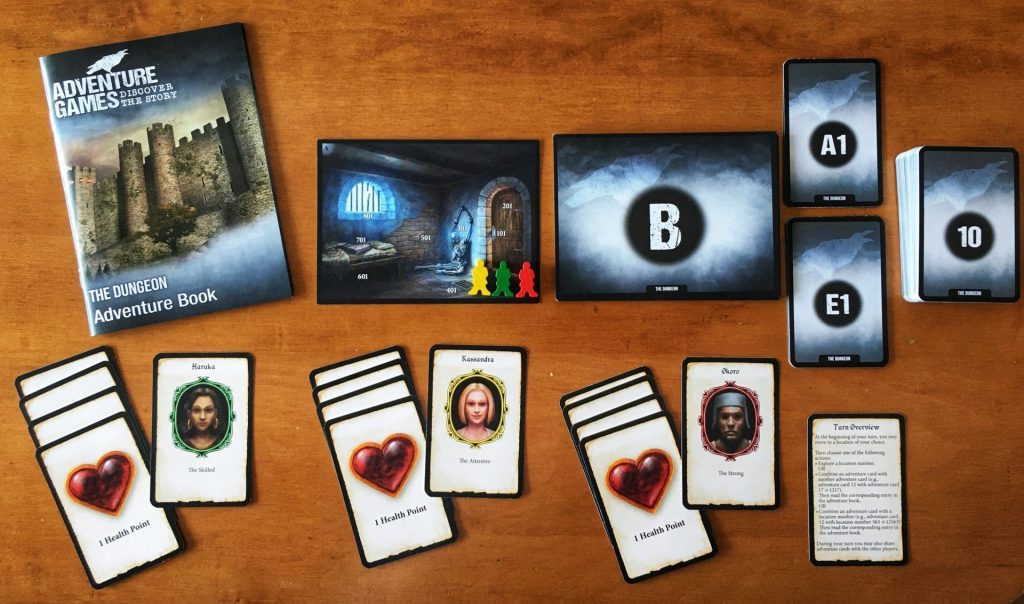
Adventure Games: The Dungeon features less complex gameplay than Monochrome Inc. because there is only one main change from the basic Adventure Games system: Health cards. Players are trying to escape imprisonment in a dungeon so each begins the game with a number of Health cards, according to player count. Over the course of The Dungeon’s story, players might lose health points. When this occurs, the affected player(s) flip over a number of Health cards to their gray side. If you’re instructed to lose health points and all your cards are on their gray side, you remove one from the game. If ever you’re down to your last gray Health card, it isn’t removed. Instead, the player on your left loses the health points you were supposed to lose. Thematically it’s as if this player’s character throws themselves in the path of danger to protect you. There are opportunities in the game to heal (flip back a card), but any Health cards removed from the game are gone forever.
Monochrome Inc. – A Slap On The Wrist
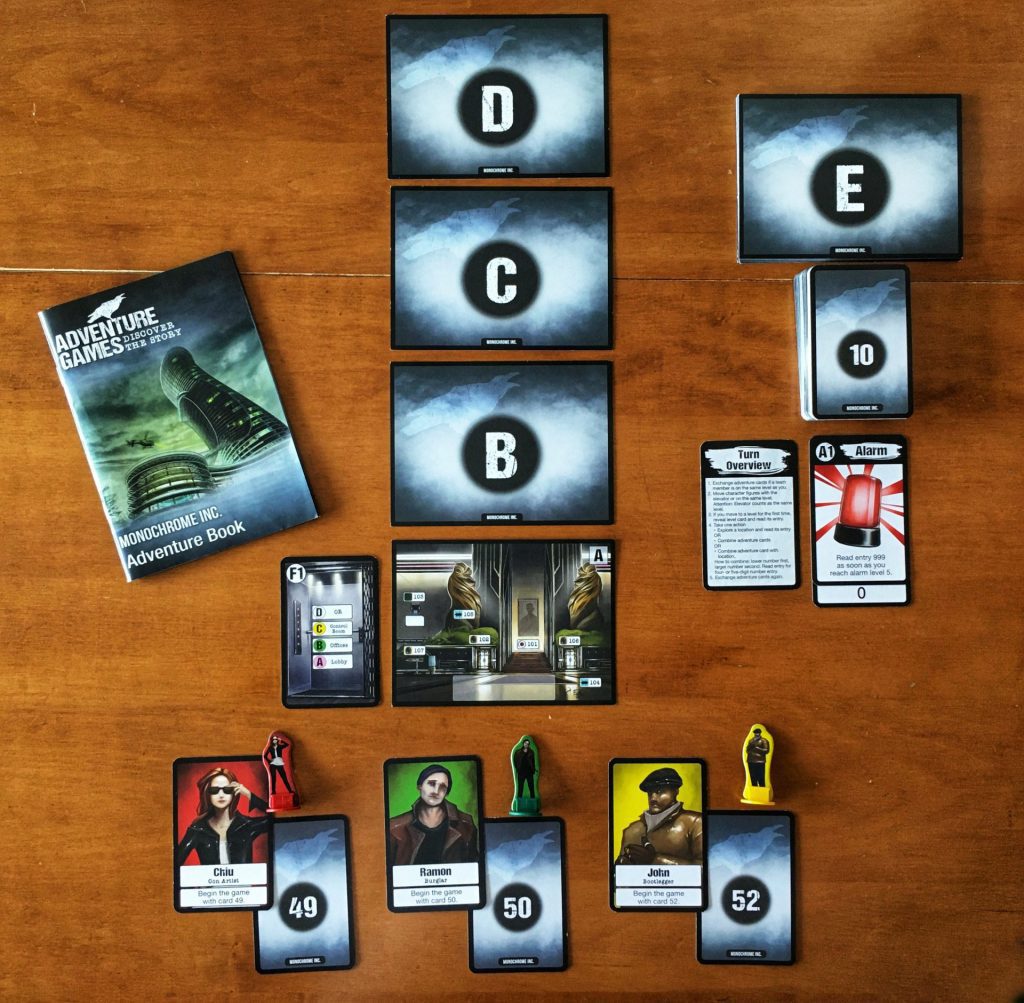
In Adventure Games: Monochrome Inc., the team assembles to break into, well, Monochrome Inc.—a pharmaceutical enterprise that has been developing a controversial new drug―with the task of learning more about this product. There are a few extra elements added to the basic gameplay in this scenario. The first is that it introduces obstacles to the game; each character begins the game with an Adventure card showing a symbol unique to them. In essence, this symbol represents your character’s greatest strength. However, this also becomes their weakness. Many location numbers in the Monochrome Inc. headquarters have symbols next to them. If a player tries exploring or combining an Adventure card with a location number matching the symbol on their starting Adventure card, then the alarm level increases. Thematically, think of it this way: if you are a renowned hacker, you’ll be the first person Monochrome Inc. investigates when their systems are hacked.
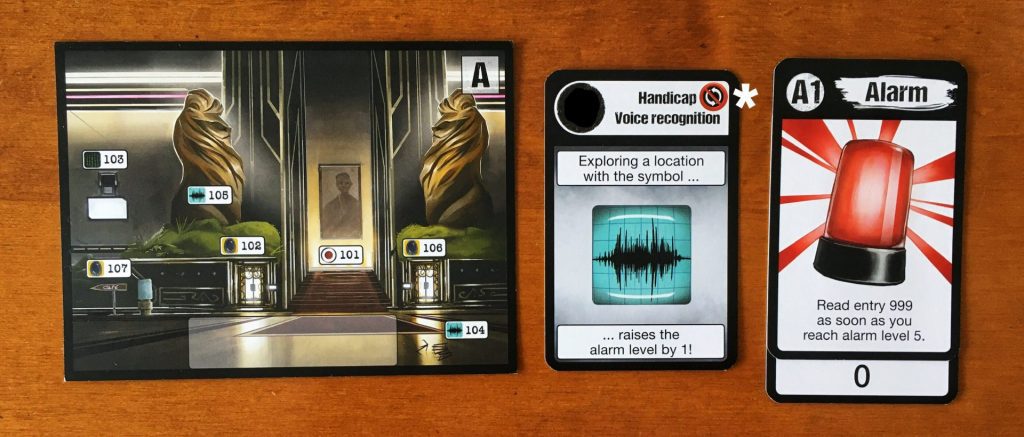
The other change to the Adventure Games basic system is how players move around and interact with each other. Since you’re breaking into this conglomerate’s HQ, players use elevators to move from one level to another. As such, players are only allowed to exchange cards at the beginning or end of their turn in Monochrome Inc. and they may only do so with players who are on the same level as them.
Thoughts from the Maple Mountain Adventuring Crew
Ashley Gariepy
I went into our first Adventure Game (Monochrome Inc.) expecting it to be a combination of escape room style puzzles with a choose-your-own-adventure feel like Escape Tales: The Awakening. As we began playing, I realized the gameplay was more focused on the adventuring and the story (similar to other board games like T.I.M.E Stories) than it was on the puzzles—and for these Adventure Games, it works!
I enjoyed having the freewill to decide where we wanted to go and what we wanted to do with the Adventure cards—even if that often led to me wanting to stick various objects into the fire or making other impulsive, reckless choices. Thankfully I had a good team of friends to rein me in. Because of this freewill to explore and do whatever we wanted within the game’s system, it left room for us to create and evolve the narrative, which naturally had us role-playing the experience. For example, in Monochrome Inc., I played a character who wasn’t very tech-savvy so whenever I encountered a passage in the Adventure Book that involved technology, I played up my role. This level of role-playing even carried over from our game of Monochrome Inc. to The Dungeon. Kathleen reached into the swimming pool in one game so naturally her new character was the first to stick their hand in a sewer grate in the next. I wanted to stab a questionable person in Monochrome Inc. so obviously I wanted to do the same to any suspicious person we encountered in…a dungeon.
My one complaint about the Adventure Games is that sometimes the language wasn’t super clear, but in general it wasn’t bad enough to take away from the engaging story or our fun gameplay experience.
Kathleen Hartin
The Adventure Games are very cool. My personal preference is for The Dungeon over Monochrome Inc. While as a whole Monochrome Inc. was fun, there were some areas where players were forced to interact with an object a certain way. This would be fine if it was always the case, but sometimes the game would give you a choice and sometimes it just wouldn’t. For instance, let’s say you look into a dark hole and see glinting eyes staring back at you. The game might then give you the options: stick your hand in the hole—read entry 12345, cautiously back away—read entry 12346. But sometimes, you have no choice at all and the game would have you sticking your hand in the hole without your say so.
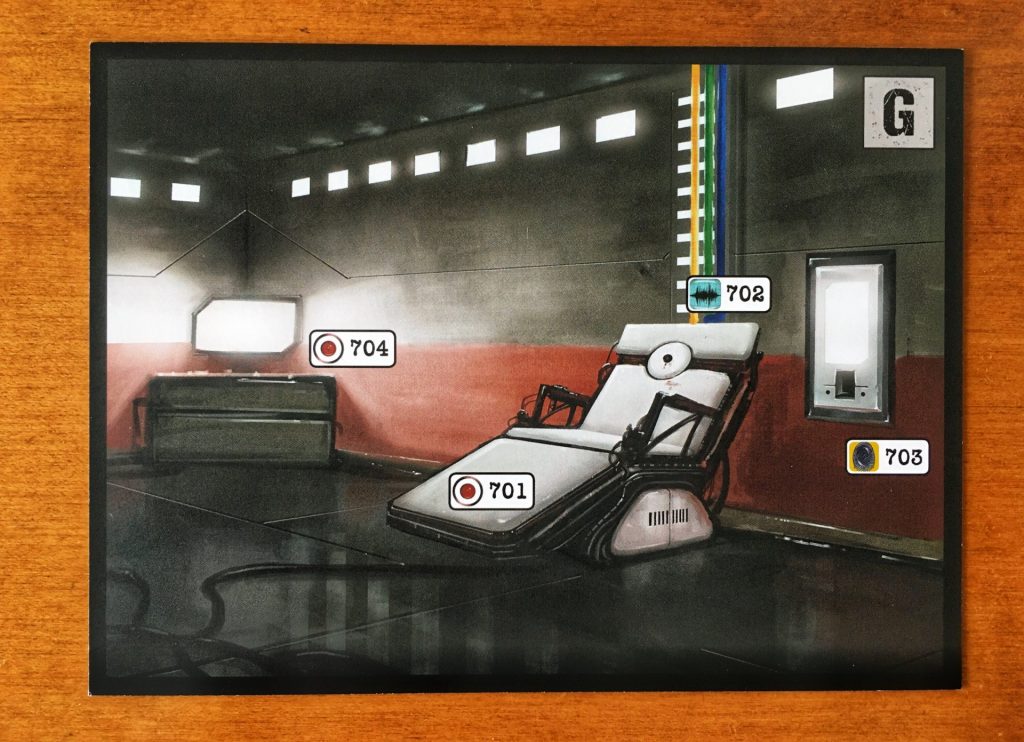
If it wasn’t enough that I was incapacitated, the way to get me out of the chair was completely unintuitive. There was a sign (location 702) that read “Warning: contact with liquids can lead to short circuits!” and below it was an unlabeled slot. So we tried combining a liquid with this location (and its strange slot) to disable the chair, but it didn’t work. In the end, the liquid needed to be combined with the chair’s location, which we felt didn’t really make sense. During this experience, I essentially checked out because there was really nothing I could do on my turn. That wasn’t much fun for me.
I found that The Dungeon was more consistent in giving you choices (but still not perfect). I think I also preferred the theme of The Dungeon more, and the Health cards were a pretty cool mechanic. The fact that other players lose health instead of a player losing their last Health card is nice because it means one player won’t be eliminated just because they’re a little unlucky, like I often was. Overall, both games are fun and absolutely worth checking out, but if you are only going to try one, I say go for The Dungeon.
Kurt Refling
Quirks and foibles aside, the Adventure Games series is one of my top picks from 2019. Both games managed to perfectly port over the feeling of classic point-and-click adventure games into a tabletop context.
As a person who grew up playing adventure games like The Secret of Monkey Island and Grim Fandango on the family computer, I have a certain nostalgia for the item collecting, puzzle-solving, and often goofy world of point-and-click adventures. What Adventure Games really nailed is that feeling of open puzzle exploration. When you get an item, you can try to use it with basically anything… to varying degrees of success. While both games are fundamentally linear experiences, the lateral thinking they encourage can lead to some fun solutions to puzzles you find along the way, and your epilogue will change based on the path you took. Adventure Games is also robust, offering a surprising amount of possible interactions between the world’s locations and the objects you’re carrying.
And much like the original point-and-click adventure games, there’s some level of risk involved. Sure, I could try to push the big red button. But is that wise? The game presents real consequences to people who blindly charge into situations and rewards those who came prepared. Of course, it’s not perfect: there are a couple of traps that feel cheap and a couple of solutions that leave you wondering how would I think of that? That’s not really surprising, since these criticisms are also levied at the point-and-click adventures that inspired this tabletop reimagining. And given the hours of play that the Adventure Games games provided, I was actually pleasantly surprised how clever and fair most of the solutions were.
The protagonists of Adventure Games may not have the charm of Guybrush Threepwood, but the fact that I could sit around a table and share this experience with friends outweighed any drawbacks from the transition to a physical space. We laughed and thought together. It was awesome. Kathleen and I liked the series so much that we bought a copy of The Dungeon for two separate friends. The Adventure Games series is a promising entrant to the escape room world, and it was one of the highlights of my 2019 in gaming.
One Last Thought
One thing that the Adventure Games have over the Exit: The Game series is that the games aren’t destroyed. And while you can’t play them again, you can pass them on to someone new to experience. This is easier to swallow for those who feel guilt over buying something just to destroy it.
So what are you waiting for? Check out Adventure Games: The Dungeon and Monochrome Inc. because you won’t be disappointed.
Thematic Music for Playing Adventure Games
Monochrome Inc.
The Adventures of Batman & Robin (Video Game Soundtrack) by Jesper Kyd
Sub-Terrania (Video Game Soundtrack) by Jesper Kyd
More info on Jesper Kyd: http://www.jesperkyd.com/
The Dungeon
The Empty Hollow Unfolds (Expanded) by raison d’être
More info on raison d’être: https://raison-detre.info/
Crypt of the Necrodancer (Video Game Soundtrack) by Danny Baranowsky
More from Danny Baranowsky: https://dbsoundworks.bandcamp.com/
This review was a collaborative piece brought to you by Maple Mountain, the self-named group of Canadian authors here at Meeple Mountain.






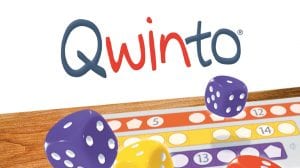






Good review! Thanks. And if I get these and play them, I think I will opt out of the App experience. I want that conversation and those inside jokes.
Thanks for the review. In these CV days, would it be possible to play this game via Zoom if both parties had the game? (2 people on each size of screen). I’m the father of an 11 year old and he’d like to get into D&D / adventure games, likewise with my friend and his son, but none of us have experience running a traditional D&D game as DM. Thought this might be a way to ease into it.
Thanks,
Dan in Los Angeles
Hi Dan,
I think you could absolutely play this over Zoom if both parties had a copy of the game. You might have to do a little upkeep when it comes to gathering the items and exchanging them during the gameplay, but I don’t think that would bog down the experience.
If you choose to play this way, I would recommend using (and reading) the included Adventure Book instead of having the app do it for you. In this case, I think it would enhance your gameplay experience.
Ashley
PS. RPGs like D&D are out of my wheelhouse, but you might want to check out this article written by fellow Meeple Mountaineer, Scriv: https://www.meeplemountain.com/articles/tabletop-rpgs-and-the-revival-of-family-game-night/ . She lists a few ideas to help get families into tabletop RPGs.